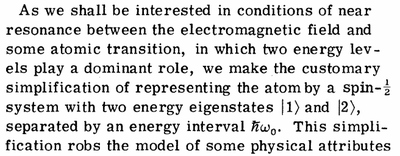Contents |
Resonance Fluorescence
Resonance Fluorescence is the incoherent light emission (fluorescence) from a system that is being excited at the same frequency than the one at which it naturally emits (resonance).
The problem can be broadly broken into two regimes of excitation, that give rise to a completely different phenomenology:
- Heitler scattering at low driving.
- Mollow triplet at high driving.
It is a fundamental problem of great interest to us, for which we are trying to establish a comprehensive timeline. We have been particularly interested in the following aspects of the problem:
- Two-photon physics of resonance fluorescence — The two-level system is actually a rich multiphoton source.[1]
- Asymmetries in resonance fluorescence — The power spectrum exhibits peculiar symmetries, which can be broken in a variety of ways.
- Transients in resonance fluorescence — Phenomena that occur before the steady state is established.
Simplest as possible, not simpler
The problem is particularly attractive because it is probably the simplest possible, yet highly nontrivial, quantum-mechanical problem, as it can be described with a two-level system. In the words of Kimble and Mandel[2]:

Most interesting phenomenon
One of the more interesting developments in recent years is the possibility of observing the fluorescent light emitted by a single confined atomic ion.
Systems
- Localized visible Ba$^+$ mono-ion oscillator. W. Neuhauser, M. Hohenstatt, P. E. Toschek and H. Dehmelt in Phys. Rev. A 22:1137 (1980). With a single confined atomic ion, see also [1].
- Resonance Fluorescence from a Coherently Driven Semiconductor Quantum Dot in a Cavity. A. Muller, E. B. Flagg, P. Bianucci, X. Y. Wang, D. G. Deppe, W. Ma, J. Zhang, G. J. Salamo, M. Xiao and C. K. Shih in Phys. Rev. Lett. 99:187402 (2007). With a self-assembled single quantum dot.
- Efficient coupling of photons to a single molecule and the observation of its resonance fluorescence. G. Wrigge, I. Gerhardt, J. Hwang, G. Zumofen and V. Sandoghdar in Nature Phys. 4:60 (2008). With a single molecule.
- Resonance Fluorescence of a Single Artificial Atom. O. Astafiev, A. M. Zagoskin, A. A. Abdumalikov Jr., Yu. A. Pashkin, T. Yamamoto, K. Inomata, Y. Nakamura and J. S. Tsai in Science 327:840 (2010). With a superconducting qubit.
Description
Here are how various people have described the process:
The phenomenon of resonance fluorescence arises with the illumination of an atomic dipole transition by resonant radiation and appears as scattering from the incident beam into other modes of the radiation field.